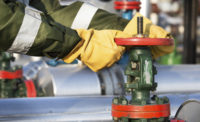By Krystal L. Mason, ScM; Kyla D. Retzer, MPH; Ryan Hill, MPH; and Jennifer M. Lincoln, PhD
Previous research has shown that fatality rates for oil and gas extraction workers were decreasing for all causes of death except for those associated with falls. (1) A new study from National Institute for Occupational Safety and Health, published in the Morbidity and Mortality Weekly Report, examined risk factors for fatal fall events in this industry during 2005-2014 using data from case investigations conducted by the Occupational Safety and Health Administration (OSHA). The study found that 63 oil and gas extraction workers died from a fall during 2005-2014, resulting in an average of 6.3 fatalities per year. This report found slightly decreasing rates (though not statistically significant) of fatal falls during 2005-2014. While the decreasing rates suggest that safety may be improving, falls are still a leading cause of death in the oil and gas industry and additional interventions could prevent deaths from falls.
Results indicate that the majority of oil and gas extraction workers who died from a fall worked for a drilling contractor and fell from a height of 30 feet or greater. Occupations most commonly involved in a fatal fall were derrickmen, who work up to 90 feet above the rig floor on the derrick board, handling pipe (Figure 1). Their work is physically demanding, repetitive, and requires a great deal of concentration. Without proper safeguards, one misstep can result in a fall fatality. Rigging up and down was also identified as a hazardous operation possibly due to the opportunity for miscommunication that is created with the simultaneous movements of large equipment, vehicles, and workers (2).
Fall protection was required by regulation in 54 of the 63 fall fatalities. Fifteen deaths occurred to workers who were wearing a harness, but fell because...Click here to read the rest of the blog post.



